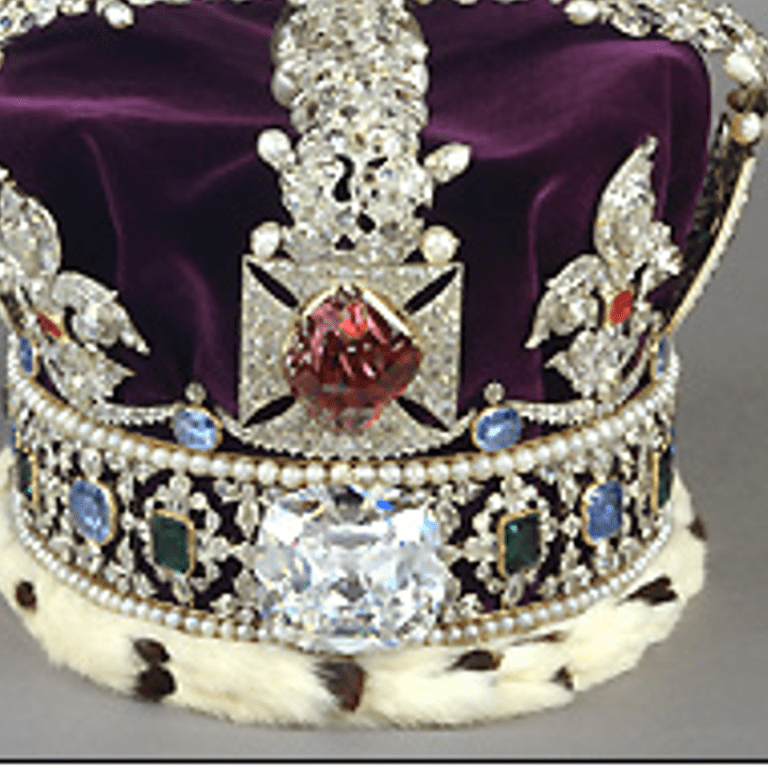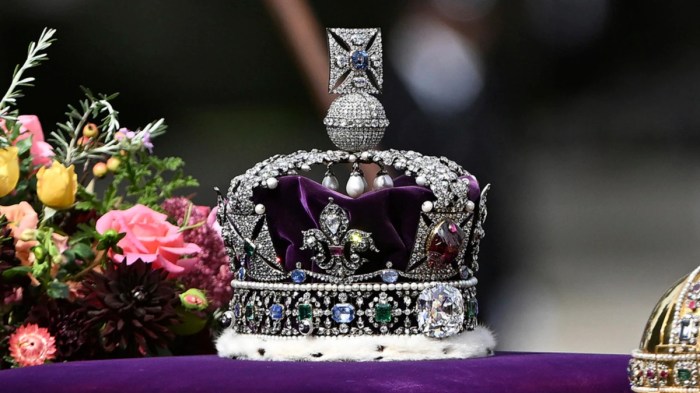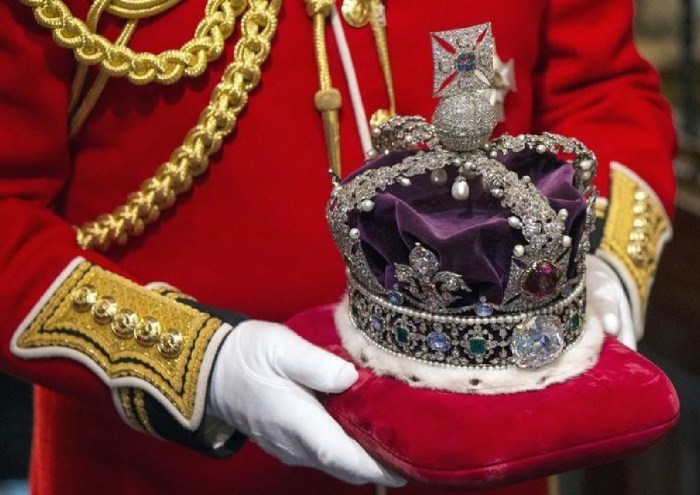Crown headband with jewels from asia – Crown headbands with jewels from Asia are exquisite adornments that have graced the heads of royalty, nobility, and performers for centuries. Steeped in cultural significance and symbolism, these headpieces embody the artistic traditions and craftsmanship of various Asian nations. This article delves into the history, design elements, craftsmanship, regional variations, and modern adaptations of these captivating headbands.
From the intricate gold filigree of India to the delicate jade carvings of China, crown headbands showcase the diverse artistry and cultural heritage of Asia. They have been worn as symbols of power, status, and celebration, and continue to inspire contemporary designers and artists.
History and Cultural Significance of Asian Crown Headbands with Jewels
Asian crown headbands adorned with jewels have a rich history and cultural significance. Their origins can be traced back to ancient times, where they were worn by royalty, religious figures, and individuals of high status. These headpieces symbolize power, authority, and divinity, and often incorporate intricate designs and precious gemstones.
Origins and Evolution
The earliest known crown headbands in Asia date back to the Bronze Age, as evidenced by archaeological discoveries in China and India. These early headbands were typically made of metal, such as gold or bronze, and were often decorated with simple geometric patterns.
Over time, the designs of crown headbands became more elaborate, incorporating precious stones, pearls, and intricate metalwork.
The evolution of crown headbands in Asia was influenced by various cultural and religious traditions. In China, for example, the emperor’s crown headband, known as the mian, was an elaborate headdress that symbolized his divine authority. In India, crown headbands were worn by both Hindu and Buddhist deities, and were often adorned with symbols of their respective religions.
Symbolism and Meanings
Crown headbands in Asia carry a range of symbolic meanings, depending on the culture and context in which they are worn. In general, they represent power, authority, and divinity. For royalty, crown headbands symbolize their status as the supreme ruler and their divine right to govern.
For religious figures, they represent their connection to the divine and their role as intermediaries between the human and spiritual realms.
The specific symbolism of crown headbands can also vary depending on the materials and designs used. For example, gold is often associated with power and wealth, while pearls symbolize purity and wisdom. Precious stones, such as rubies and sapphires, are believed to possess magical properties and are often used to ward off evil.
Notable Examples
There are numerous notable examples of crown headbands with jewels from different Asian countries. Some of the most famous include:
- The Mian (China): The emperor’s crown headband, adorned with pearls, jade, and precious stones, symbolized his divine authority.
- The Mukuta (India): A Hindu crown headband worn by deities, often decorated with symbols of the god or goddess it represents.
- The Papak (Indonesia): A traditional Javanese crown headband made of gold and velvet, worn by the sultan and other royal figures.
- The Tiara (Japan): A crown headband worn by the emperor and empress, made of gold and adorned with precious stones.
- The Gat (Thailand): A crown headband worn by the king, made of gold and decorated with rubies, sapphires, and diamonds.
Design Elements and Materials

Asian crown headbands with jewels exhibit a rich diversity of design elements and materials, reflecting the cultural and artistic traditions of their respective regions. These headpieces are characterized by their intricate craftsmanship, incorporating a range of materials, including gold, silver, gemstones, and enamel, to create stunning and opulent adornments.
The design of Asian crown headbands often incorporates traditional motifs and symbols, such as flowers, dragons, and phoenixes, which hold cultural and religious significance. The shape and size of the headband can vary depending on the region and period, ranging from delicate circlets to elaborate tiaras.
Color also plays a significant role, with certain colors being associated with specific occasions or social status.
Materials
The choice of materials used in the construction of Asian crown headbands is influenced by cultural preferences, availability of resources, and the skill of the artisans. Gold and silver are commonly used for their durability, malleability, and symbolic association with wealth and power.
Gemstones, such as rubies, emeralds, and sapphires, are incorporated to enhance the beauty and value of the headpiece. Enamel, a type of vitreous material, is often used to create colorful and intricate designs on the surface of the headband.
Ornamentation
Ornamentation is a key element in the design of Asian crown headbands. Filigree, a technique involving delicate metalwork, is commonly used to create intricate patterns and textures. Granulation, the application of tiny metal beads, is another popular technique that adds depth and sparkle to the headpiece.
Pearls and other gemstones are often used as embellishments, adding to the overall opulence and beauty of the design.
Craftsmanship and Techniques: Crown Headband With Jewels From Asia

The creation of crown headbands in Asia involves intricate craftsmanship and a range of traditional techniques that have been passed down through generations. Skilled artisans employ these techniques to produce exquisite pieces that showcase their artistry and cultural heritage.
Metalworking
Metalworking is a crucial aspect of crown headband making. Artisans use various metals, such as gold, silver, and copper, to create the intricate framework of the headbands. They employ techniques like hammering, forging, and filigree work to shape and embellish the metal, creating intricate designs and patterns.
Stone Setting
Crown headbands often feature precious and semi-precious stones that add brilliance and opulence to the pieces. Artisans use a variety of stone setting techniques, including prong setting, bezel setting, and pave setting, to securely mount the stones on the metal framework.
The precision and skill required for stone setting ensure that the stones remain in place and enhance the overall beauty of the headband.
Embroidery
Embroidery is another common technique used in the creation of crown headbands. Artisans use threads of different colors and textures to create intricate patterns and motifs on the fabric lining or embellishments of the headband. The embroidery adds a touch of elegance and personalization to each piece, making it a unique and treasured item.
4. Variations and Regional Styles
Crown headbands with jewels exhibit remarkable regional variations across Asia, reflecting diverse cultural influences and artistic traditions.
Each country and region has developed unique characteristics in the design, materials, and cultural significance of their headbands.
China
Chinese crown headbands are typically elaborate and ornate, featuring intricate filigree work, gemstones, and pearls. They often symbolize power, status, and wealth.
The fengguan, a traditional headdress worn by empresses and noblewomen, is one of the most iconic examples of Chinese crown headbands.
Japan
Japanese crown headbands are known for their elegance and simplicity. They often incorporate traditional motifs such as flowers, birds, and waves.
The kanzashi, a decorative hair ornament used in traditional Japanese hairstyles, can be worn as a crown headband.
India
Indian crown headbands are often colorful and opulent, featuring intricate beadwork, embroidery, and gemstones.
The maang tikka, a traditional head ornament worn by brides, is a popular type of Indian crown headband.
Other Countries
Crown headbands with jewels are also found in other Asian countries, including Thailand, Cambodia, and Vietnam.
Each country has its own unique variations, influenced by local customs and traditions.
| Country | Design | Materials | Cultural Significance |
|---|---|---|---|
| China | Elaborate, ornate | Filigree work, gemstones, pearls | Power, status, wealth |
| Japan | Elegant, simple | Traditional motifs (flowers, birds, waves) | Beauty, femininity |
| India | Colorful, opulent | Beadwork, embroidery, gemstones | Marriage, celebration |
| Other Asian Countries | Vary by country | Local materials and motifs | Cultural identity, tradition |
Modern Adaptations and Contemporary Uses

Traditional crown headbands from Asia have undergone significant adaptations to suit modern fashion and accessories. These headpieces are now widely used in contemporary jewelry design and cultural performances.
In modern fashion, crown headbands have become a popular accessory, adding a touch of glamour and sophistication to any outfit. They are often adorned with gemstones, pearls, and intricate metalwork, and can be worn for special occasions or everyday wear.
Contemporary Jewelry Design
In contemporary jewelry design, crown headbands have been reimagined as unique and eye-catching pieces. Designers incorporate traditional elements, such as lotus flowers and dragon motifs, into their creations, using a variety of materials including gold, silver, and gemstones.
- Amrapali Jewels:Known for its exquisite craftsmanship, Amrapali Jewels incorporates traditional Indian crown headband designs into its contemporary jewelry collections.
- Cartier:The renowned French jewelry house has created a collection of crown headbands inspired by the opulence of Asian royalty, featuring intricate filigree work and precious gemstones.
Cultural Performances, Crown headband with jewels from asia
Crown headbands continue to play an important role in cultural performances across Asia. They are worn by dancers, musicians, and actors to enhance their stage presence and convey cultural traditions.
- Chinese Opera:In Chinese opera, crown headbands are elaborate headdresses that symbolize the characters’ status and personality.
- Japanese Kabuki:Kabuki actors wear ornate crown headbands called “kanmuri,” which are intricately decorated with gold, silver, and lacquer.
FAQ
What is the significance of crown headbands in Asian cultures?
Crown headbands have been worn in Asia for centuries as symbols of power, status, and celebration. They are often associated with royalty, nobility, and religious figures.
What are the common design elements of Asian crown headbands?
Asian crown headbands typically feature intricate designs that incorporate gold, silver, gemstones, and other precious materials. They often include motifs such as dragons, phoenixes, and flowers.
How are Asian crown headbands made?
Crown headbands are made using a variety of traditional craftsmanship techniques, including metalworking, stone setting, and embroidery. Skilled artisans use these techniques to create unique and elaborate pieces.
What are the regional variations in Asian crown headbands?
Crown headbands vary in design and style depending on the region of Asia in which they are made. For example, Chinese crown headbands are often made of gold and feature intricate filigree work, while Japanese crown headbands are often made of lacquered wood and feature delicate carvings.
How are crown headbands used in modern times?
Crown headbands are still worn today as traditional attire in some Asian cultures. They are also used as fashion accessories and in contemporary jewelry design.